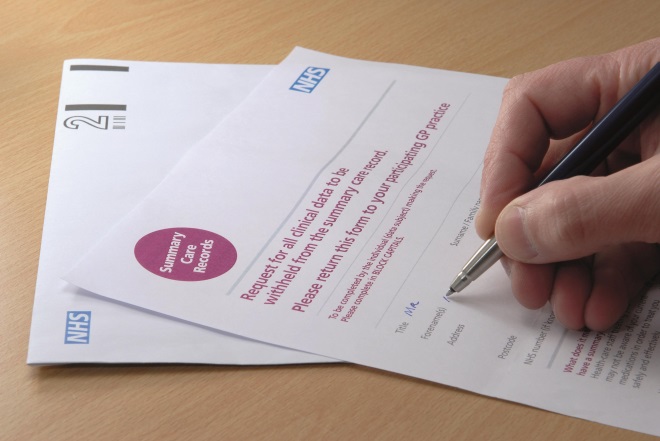
Paul Cantrell
It’s Saturday morning and a young man, let’s call him John, comes into the pharmacy. John is asthmatic and has run out of his inhalers. He doesn’t have a prescription from his GP and the GP surgery is closed.
He appears in need of the drugs, but as John does not use the pharmacy regularly, the pharmacy records cannot confirm that he has been prescribed the inhalers before.
Usually a patient like John would be asked to ring the GP out-of-hours service, NHS 111 or, if appropriate, wait until Monday and call his GP surgery, but things are a little different at Wicker Pharmacy in Sheffield. The pharmacy is one of 140 chosen to pilot pharmacy access to the patient summary care record. For the past year, pharmacists and pharmacy technicians there have been able to access the summary care record with patient consent.
James Wood, a pharmacist at Wicker, explains to John that he can issue an emergency supply but needs to be able to confirm that John is regularly prescribed the inhalers he is asking for. He asks John whether he would consent to him to looking at his NHS summary care record, which will show the medicines he has been prescribed in the past 12 months, along with any allergies and adverse reactions.
The patient gives consent straight away. Wood puts his NHS smart card into the computer behind the counter and taps in his unique log in information to access the system. He quickly finds the information he needs – he can see that the inhalers are prescribed regularly and that the last prescription was written more than a month ago. John leaves the pharmacy with the inhalers he needs and has avoided having to make a trip to another healthcare service.
“It is much more straightforward for the patient; where the patient presents we can actually take care of them,” Wood explains.
Over the next 18 months, community pharmacists and pharmacy technicians across England will, after training, be given similar access to the summary care record as the pilot scheme is rolled out.
The roll out follows an evaluation of the pilot[1]
, published in June 2015 by the Health and Social Care Information Centre (HSCIC), which analysed the value of the 1,900 times summary care records were accessed between September 2014 and March 2015. While the report cited reduced waiting times and avoiding unnecessary referrals to another healthcare service as evidence of an improvement in patient experience and was roundly endorsed by pharmacists, it provided little evidence of support from patients.
Research into whether patients are willing to allow pharmacists to access their GP record, or a summary of their record, should give insight into the likely success of pharmacy use of summary care records and, ultimately, as pharmacy organisations hope, full read and write access to GP records. Integral to this, however, is the need to overcome a perception that high street pharmacies are commercial businesses rather than clinical settings while also addressing misinformation in the British press.
Speeding up the process
At the ten pilot sites with the highest usage of summary care records (where records were accessed between 109 and 598 times), 623 patients were asked to complete a questionnaire to better understand their experience. Just 15 responses had been returned by the time the pilot evaluation report was completed and did not form part of the initial HSCIC evaluation.
As of September 2015, the HSCIC had received 50 completed questionnaires. Of these 50 patients, almost all (98%) said that allowing the pharmacist to access the summary care record meant that they did not have to go to another NHS service to obtain the medicine they needed, and 90% said that treatment was quicker as a result. A total of 35 patients (70%) said that receiving treatment from the pharmacist meant they could continue with their evening, weekend or holiday rather than spend time visiting a GP or another NHS service, and 21 patients (42%) said that it meant they would avoid having to take time off work to visit a GP or another care service.
Forty-five patients (90%) said they felt more confident in the treatment they received once their pharmacist had access to the summary care record, and 88% said they were more likely to return to the pharmacy for treatment as a result. Almost all patients (96%) said that pharmacist access to the summary care record gave them more choice about their care.
Wicker Pharmacy was one of the ten pilot sites with the highest usage of care records.
“Patients were very happy to give consent for us to view their care record,” says Wood, who is the pharmacy’s superintendent pharmacist. “We thought that at some point we might have some difficult conversations. But throughout the pilot, of all the people that we asked, which was in the hundreds, no one denied consent.
“Some said to us ‘why are you asking, don’t you have access anyway?’.”
Rosemary Blackie, another pharmacist working for Wicker, echoes Wood’s take on the pilot. “Nobody batted an eyelid,” she says.
It is in the evening and at weekends that pharmacists usually need to access care records, and during the pilot this happened at least five times each week, says Blackie. Most of the patients asked for an emergency supply of a medicine, sometimes bringing pills with no marking, or chasing a prescription that had not arrived. Without access to the care record, Blackie says she would not have been able to supply medication. “That’s the long and short of it really,” she says.

As pharmacies begin to use summary care records more routinely in their practice, patients will become more comfortable with it, says Matthew Boyd, assistant professor in pharmacy practice at the University of Nottingham
Little other research has been conducted on how patients feel about pharmacists having access to their GP records. Researchers at Nottingham University School of Pharmacy, led by Matthew Boyd and Helen Boardman, surveyed more than 7,000 customers aged over 18 years at 31 pharmacies to ask whether they were comfortable with pharmacists having access to their GP records for the purposes of giving a vaccination[2]
.
Over four-weeks from mid-February 2015 — just before it was announced that pharmacies in England would offer flu vaccinations as part of the community pharmacy contractual framework — 7,154 customers completed surveys. Their answers revealed that 80% (n = 5,362) of respondents were happy for the pharmacist to have access to their GP record to check that a vaccine was suitable for them.
Reasons given by customers in support of access included improving the safety of the service, having trust in the pharmacist, and the need for communication and continuity of care between health professionals. Comments included “of course the pharmacist would need to know this information to make sure it’s safe” and “the more educated the pharmacist is about my health needs, the better they can help”.
A minority of customers raised concerns over their privacy and who could access the information. Some of those surveyed questioned whether pharmacy access was necessary. And one respondent was against access because they had experienced a data breach in another healthcare setting.
“Generally people are positive but there are a few people who are still concerned,” says Boyd, assistant professor in pharmacy practice at the University of Nottingham. Any negative perceptions about pharmacists accessing patient records could be improved by raising public awareness about the role of pharmacy and informing patients about why a pharmacist might need access. “Pharmacists just need to be a little more transparent, tell people what they are about, how they work and as they drive to more service-led practice that is going to happen more and more.”
And Boyd predicts that as pharmacies begin to use summary care records more routinely in their practice, patients will become more comfortable with it. “Attitudes will change over time,” he says.
This view is shared by Pene Wood, associate lecturer in clinical pharmacy at La Trobe University in Bendigo, Victoria, who believes more needs to be done to promote public awareness of pharmacists and their qualification as a health professional and medication expert.
In Australia, people can opt in to having a personally controlled electronic health record (PCEHR), which contains a summary of their health including conditions, medications, allergies, vaccinations and an indexed overview of specific healthcare events. Patients have access to their PCEHR online and can control what the record contains and who is able to access it.
Researchers from La Trobe distributed a questionnaire to 217 people attending clubs for retired or semi-retired individuals to find out whether they were comfortable sharing their health record with various health professionals.
Respondents were generally happy to give GPs, specialists, hospital medical staff and emergency personnel full access to their PCEHR. Willingness to grant access to other allied health professionals ranged from 29% for carers to 48% for diagnostic laboratories[3]
. Only 44% of respondents were willing to provide full access to pharmacy.
The researchers suggest that lack of understanding of the pharmacist’s role may be to blame. “I don’t think a lot of people in the community really understand what it is exactly that pharmacists do,” says La Trobe’s Wood.
Elderly patients in particular didn’t see pharmacists as medication experts and would often respond with “my doctor would have checked that” or “my doctor knows what he is doing”, says Wood.
“Perhaps the best way to get this message out there is from the doctors, so the patient realises ‘hey my doctor is OK with this, the pharmacists are not questioning my GP but working alongside them in different roles’,” she says.
Bad press
In August 2015, an article in
The Telegraph
[4]
warned that pharmacist access to records would mean that companies such as Boots and Tesco would be able to access patient data and could use it for marketing purposes. Phil Booth from campaign group medConfidential told The Telegraph that the valuable data would prove “irresistible” to commercial firms, which could exploit the data. Other national newspapers followed suit with similar scaremongering stories, prompting NHS England to reassure the public that existing data protection legislation effectively bans the use of medical records for commercial gain.
Such reassurances will need to be reinforced, especially when security lapses happen or when companies are caught falling short of expected standards, as was the case with online pharmacy company Pharmacy2U, which was fined £130,000 in October 2015 for selling customer details to marketing companies without their consent.
NHS England has emphasised that patient consent will be required each time a pharmacist accesses their SCR, and that this access will be documented in the record.
“There are data sharing agreements all the way through the NHS because a number of secondary care and tertiary care services are provided by private providers,” says Boyd. However, he suspects that because high street pharmacies are instantly recognisable as commercial businesses, patients have greater concerns about them accessing their data compared with other private providers.
Question of trust
All NHS providers, including community pharmacies, must provide information governance assurances to the NHS every year. Part of these safeguards around use of patient information include developing a staff confidentiality code of conduct and ensuring that staff are sufficiently trained in information governance. Pharmacies must also create a patient information leaflet on how data are handled by the pharmacy and must have procedures in place to manage access control and data transfer. Ensuring patient confidentiality is also a vital part of the clinical governance requirements in the community pharmacy contractual framework.
Nigel Mathers, honorary secretary of the Royal College of General Practitioners in the UK, says patients must be assured that pharmacists are bound by the same confidentiality rules as GPs and that access to records has potential patient safety benefits.
“Giving pharmacists access to relevant information will help them to give advice to patients based on an accurate medical and drug history,” he says.
In his role as an independent prescriber who works closely with a GP practice, Ash Soni, president of the Royal Pharmaceutical Society (RPS), which publishes The Pharmaceutical Journal, has been permitted to access the full GP patient record for several years. When he asks for permission to access records, patients are surprised that pharmacists don’t already have access, he says. “There is a misconception among members of the public that assumes pharmacists already have this access,” he adds.
However, Soni acknowledges that with the roll out of access to summary care records by the HSCIC, some patients will inevitably express concerns about privacy.
Boyd’s Nottingham study found that customers who said they would allow their pharmacist access to their GP record were more likely to report using the same pharmacy than those who would not allow access (83% [n = 4,371] versus 79% [n = 1,058]). This could indicate that customers are more comfortable with access when they have a relationship with their pharmacist, says Boyd.
Customers who would allow record access were more likely to report that they trusted the pharmacist to provide good advice than those who would not allow access (74% [n = 3,946] versus 68% [n = 928]).
Boyd and his fellow researchers have yet to break down their results to see whether the age of customers impacted on acceptance of pharmacy access to records. But he notes that 38% of customers surveyed were aged under 50 years, which may not reflect the profile of patients who use pharmacies to pick up prescriptions.
Moving forward
As part of the roll out of access to the summary care record, pharmacists and pharmacy technicians will receive face-to-face briefing sessions delivered locally on how to use the care records. They will also be given advice on explaining the value of access to the patient in order to alleviate any concerns. An e-learning module developed by the Centre for Pharmacy Postgraduate Education (CPPE) is also available.
Soni anticipates that the vast majority of patients will allow access, although there will undoubtedly be a few with deep-rooted concerns about data sharing who will refuse. He is confident that the roll out of care records access will benefit patients.
“This is a real opportunity for pharmacists to do more and be better integrated into the way health and social care is delivered,” he says, adding that the summary care record roll out is only the start of the journey.
The RPS launched a campaign in October 2015 to gain read and write access to the full GP record because it believes such a move will further improve patient care and safety. “We need to have write access as well – so we can write to the record,” says Soni. Without write access, pharmacists have “to use all sorts of work arounds”, Soni says.
Wicker’s James Wood agrees that being able to write to the record would be useful as it would ensure that any action the pharmacist took was recorded immediately.
At the moment, if a pharmacist issues an emergency supply of a drug he or she has to give this information to the GP, either via a phone call or confidential email. “Then of course they have to annotate the records themselves,” Wood explains. At best this introduces a delay to the information being incorporated and at worst the information can go astray and never be added.
“It would be much easier if we could do it,” he admits.
Timeline: moving towards digital patient records
1998: The Data Protection Act 1998 enables patients to request to see their GP healthcare record.

Source: Alamy
December 2003: Health secretary John Reid (pictured) announces plans for every NHS patient in England to have an individual electronic NHS care record.
May 2007: The summary care record (SCR), containing key clinical information, is introduced in six early adopter primary care trusts.
2009-2010: Strategic health authorities begin uploading SCRs to the NHS spine. The number of records being uploaded accelerates.
April 2010: Connecting for Health, the agency charged with implementing the NHS National Programme for IT, suspends roll out of the SCR because of concerns that the process is happening too rapidly, patients do not have enough information, and that it is too hard for them to opt out.
June 2010: A Department of Health-commissioned evaluation of the SCR programme is published. In response to the report’s recommendations, clinicians are required to ask for a patient’s consent before accessing their SCR.

Source: Alamy
April 2011: Mailings to thousands of patients in England about the introduction of the SCR resume with a prepaid envelope to make it easier for patients to opt out.
September 2014: Pharmacist access to the SCR is piloted in 140 pharmacies in five geographical regions in England. SCRs are accessed over 1,900 times between September 2014 and March 2015.

Source: Department of Health
June 2015: Health minister Alistair Burt (pictured) announces that all community pharmacists across England will be given the opportunity to access the summary care record.
September 2015: The Royal Pharmaceutical Society launches a campaign for pharmacists to have ‘read and write’ access to health records when consulting patients and dispensing medicines.
Autumn 2015: National roll out of pharmacists’ access to the summary care record begins. Roll out is expected to be completed around autumn 2017.
From September 2016: Originally planned for March 2015, all NHS patients in England will have online access to their GP records.
2018: Clinicians in primary, urgent and emergency care will be operating without needing to use paper records.
From March 2018: Patients will have the ability to ‘write’ into their own record but will not be able to edit the entries their clinician has made.
2020: All care records will be digital, real-time and interoperable.
References
[1] Health and Social Care Information Centre. Community pharmacy access to Summary Care Records Proof of Concept report v1.1. Available at: http://systems.hscic.gov.uk/scr/library/poc_report.pdf
[2] Mahmood H, Tse S, Chung Li W et al. Community pharmacy vaccination services: customers’ perceptions of pharmacist access to GP records. Research Session 2: Primary care and community practice. International Journal of Pharmacy Practice 2015;23:9–14. doi:10.1111/ijpp.12210
[3] Kerai P, Wood P & Martin M. A pilot study on the views of elderly regional Australians of personally controlled electronic health records. International Journal of Medical Informatics 2014;8(3):201–209. doi:10.1016/j.ijmedinf.2013.12.001
[4] Donnelly L. Boots, Tesco and Superdrug to get access to NHS medical records. Daily Telegraph 9 August 2015. Available at: http://www.telegraph.co.uk/news/health/11790711/Boots-Tesco-and-Superdrug-to-get-access-to-NHS-medical-records.html


